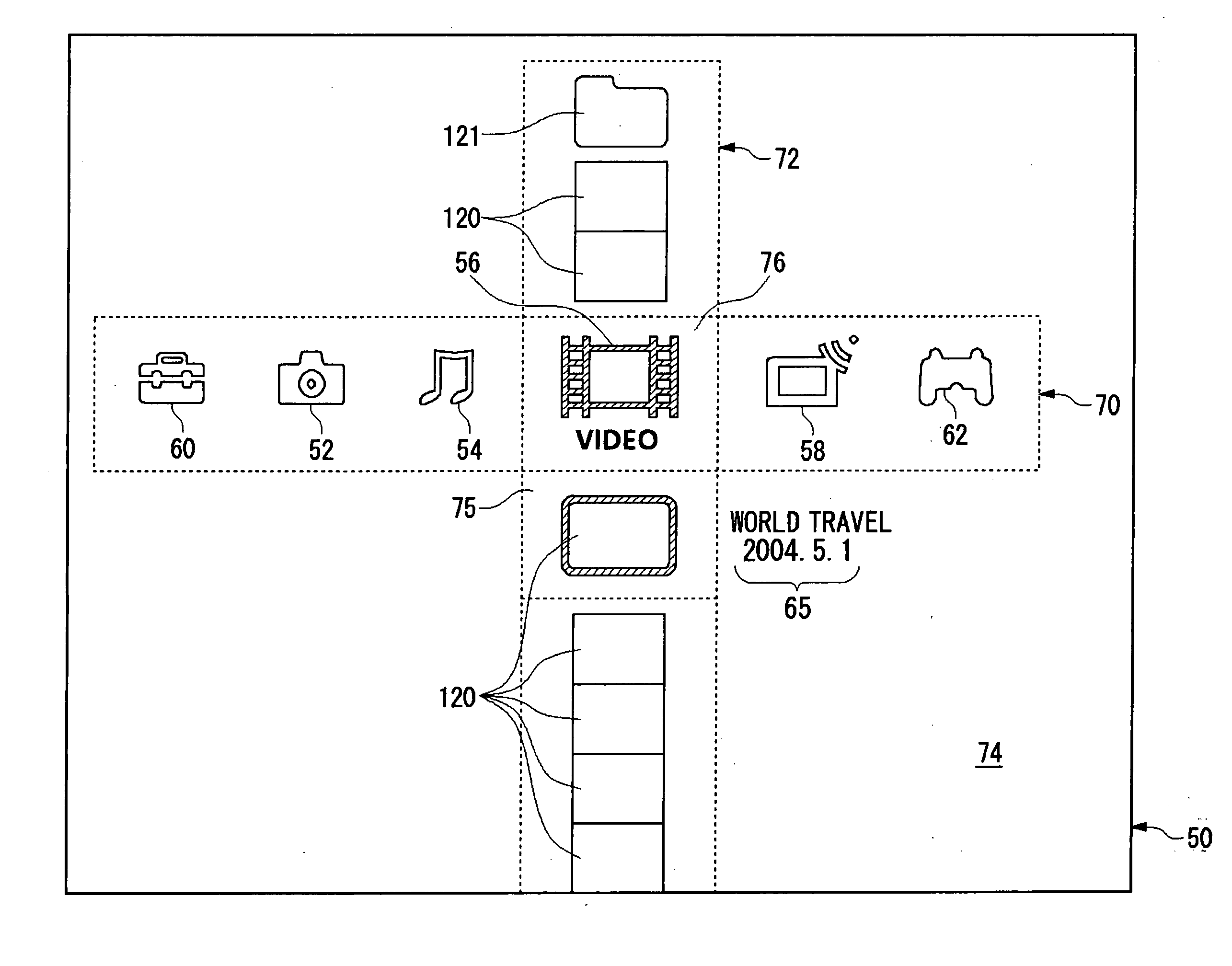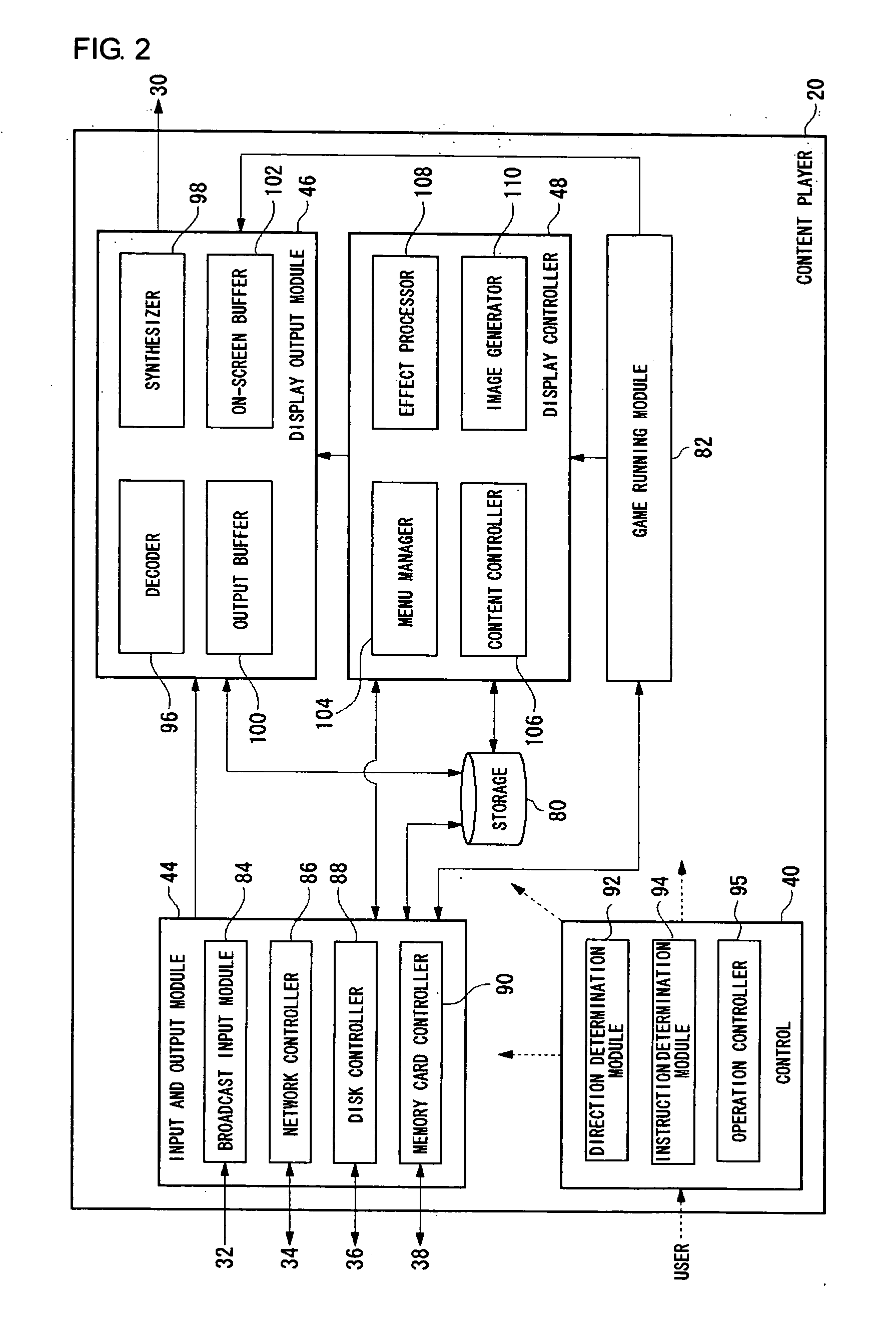Content Reproduction Device and Menu Screen Display Method
a content reproduction device and menu screen technology, applied in the field of content players, can solve the problems that the characters in small sizes or the movement of the small pointer as displayed on the pc screen are not suitable for display on the pc screen, and non-pc users may not necessarily feel comfortable, so as to achieve enhanced user convenience in content playing and convenient use.
- Summary
- Abstract
- Description
- Claims
- Application Information
AI Technical Summary
Benefits of technology
Problems solved by technology
Method used
Image
Examples
first embodiment
[0033] A content player according a first embodiment of the present invention is a multifunction device capable of playing or running multiple types of contents such as still images, moving images, music, broadcast and games. The device is designed to use a screen of a television set. To manipulate the device, users use items displayed on a screen and directional buttons on a controller. In order to play multiple contents on a PC, programs, such as a viewer, dedicated to the content type need be used. These dedicated programs are produced by different vendors. Normally, they do not share a common interface nor provide consistent feel as the user uses the programs. Integrating these dedicated programs under a common interface such as a portal screen would merely result in aggregation. Further, because it requires more than a little time to start each program, users cannot comfortably switch between programs.
[0034] A content player according to the embodiment integrates playing of mu...
second embodiment
[0071] The method of representation in a second embodiment is similar to that of the first embodiment in that tags are attached to content icons but differs from the first embodiment in respect of the style of tags such as the size thereof. The following description focuses on the difference from the first embodiment.
[0072]FIGS. 7A-7D schematically show a method of representing the hierarchy of contents according to the second embodiment. FIG. 7A shows a state prior to expanding the folder icon 121. FIG. 7B shows a state in which the folder icon 121 is expanded so that the items 123 are displayed. The effect processor 108 attaches first tags 300 to the folder icon 121 and the items 123 to indicate that they are targets of expansion in the first layer. In this process, tags are not attached to the content icons independently but are attached to the whole of targets of expansion as a unit.
[0073] When the control 40 acquires an instruction to expand the item 123 marked “1”, the effec...
third embodiment
[0078] The method of representation in a third embodiment is similar to that of the first and second embodiments in that tags are attached to content icons but differs from the first and second embodiments in respect of the method of attaching tags. The following description focuses on the difference from the first and second embodiments.
[0079]FIGS. 9A-9D schematically show a method of representing the hierarchy of contents according to the third embodiment. FIG. 9A shows a state prior to expanding the folder icon 121. FIG. 9B shows a state in which the folder icon 121 is expanded so that the items 123 are displayed. The effect processor 108 attaches the first tags 300 to the folder icon 121 and the items 123 to indicate that they are targets of expansion in the first layer. In this process, tags are not attached to the content icons independently but are attached to the whole of targets of expansion as a unit. In this respect, the third embodiment is similar to the second embodime...
PUM
 Login to View More
Login to View More Abstract
Description
Claims
Application Information
 Login to View More
Login to View More - R&D
- Intellectual Property
- Life Sciences
- Materials
- Tech Scout
- Unparalleled Data Quality
- Higher Quality Content
- 60% Fewer Hallucinations
Browse by: Latest US Patents, China's latest patents, Technical Efficacy Thesaurus, Application Domain, Technology Topic, Popular Technical Reports.
© 2025 PatSnap. All rights reserved.Legal|Privacy policy|Modern Slavery Act Transparency Statement|Sitemap|About US| Contact US: help@patsnap.com



